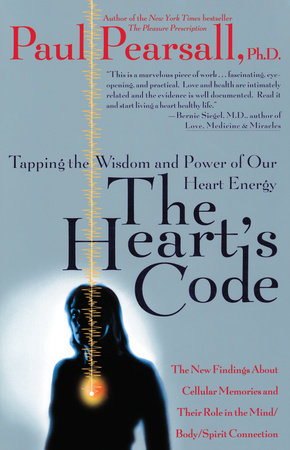Excerpt
The Heart's Code
First Scientific Contact with the Soul?Science has recently discovered three startling new possibilities regarding how we think, feel, love, heal, and find meaning in our life. This research suggests that the heart thinks, cells remember, and that both of these processes are related to an as yet mysterious, extremely powerful, but very subtle energy with properties unlike any other known force. If the preliminary insights regarding these prospects continue to be verified, science may be taking the first tentative steps to understanding more about what shamans, kahuna, priests, spiritual leaders, and healers from ancient traditional medicines have been teaching about for centuries—the energy of the human spirit and the coded information that is the human soul.
The research and true life stories presented in this book will introduce preliminary documentation that is offering clues about the heart's code, the phrase I will use throughout this book to represent a proposed subtle life or "L" energy "cardio-cryptogram." This heart's code is recorded and remembered in every cell in the body as an informational template of the soul, constantly resonating within and from us, sent forth from our heart.
Toward One World MedicineBy exploring the possibility of a heart's code, we may be able to begin to build a bridge between the biomechanical wonders of modern medicine, the spirituality of ancient traditional healing systems, the various alternative or complimentary medicines, and the wisdom of religious scholars and spiritual leaders. It is not likely that we will be able to understand all the forms of medicine in the world until we are willing to broaden our understanding of the world. By doing so, we may not have to select from among all the models of healing. Instead, perhaps we can combine them into one world medicine made up of all the wisdom about the brain, body, energy, information, the spirit, and the soul. With sufficient patience, tolerance, creativity, a more inclusive view of the human system as it interacts with all systems, and perhaps most of all, with a more open heart and less defensively reactive brain, we may be able to combine the rigor of science with the subtle wisdom of the heart to answer the most important questions in the universe: what and why is life?
The Burden Of PrudenceThe hypotheses regarding the heart's code are without doubt among the boldest proposals any scientist could make. I offer them to facilitate more discussion and study and as new possibilities to be explored as medicine experiences its growing pains associated with the challenges in dealing with the issues of spirituality and mortality, which are of such deep concern to patients, and the lessons of so-called alternative or complementary medicines. These are proposals that many of my scientific colleagues often say they "have a very hard time accepting." Surgeon Dr. Bernie Siegel is the well-known author of
Love, Medicine and Miracles and other books that deal with ideas about mind/body/soul interactions that many of his colleagues still refuse to accept, get angry with, and often consider strange and even crazy. He writes, "What disturbs me is the use of the word 'accept.' If we close our minds and don't accept, science and healing cannot move forward. Instead of 'hard to accept,' let us say, 'hard to understand.'"
Using our current scientific way of thinking, it is very difficult to understand how the heart could have a code, a cell could have a memory, and an immeasurable form of energy could contain information about the soul. I suggest that we should study these ideas precisely because they are "non-sense." They do not make sense in terms of science's current ways of trying to explain the mysteries of life. Perhaps these new possibilities regarding the heart's code will offer some new ways to come to our senses about the meaning of life and the processes of healing.
In the mid-1800s, the idea that tiny germs invisible to the eye could make us sick was seen as "utter nonsense" by the medical leaders of that time. Based on seemingly strange but recurring reports from patients and some doctors and nurses about the suffering that seemed to be caused by dirty hands delivering babies, and thousands of needless deaths caused by the use of scalpels still defiantly sharpened on the bottom of the surgeon's boot to show disdain for the silly "germ theory," doctors began to reluctantly accept the possibility of the existence of imperceptible but deadly microorganisms. This doubting acceptance allowed the development of more understanding about invisible things causing visible consequences, and doctors began to wash their hands and sterilize their instruments before any medical procedure. Today, because of the historical prudence of their predecessors, the burden of proof has been met and doctors understand much more—but not all—about bacteria. This same cautious but accepting prudence is required if we are to learn more about the existence of a heart's code and the cellular memories it conveys.




